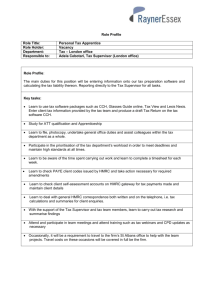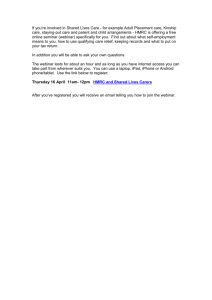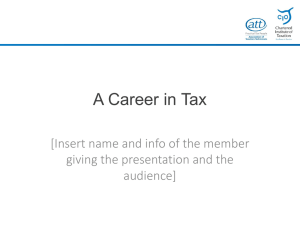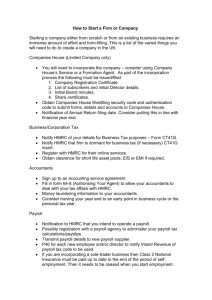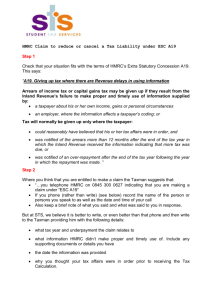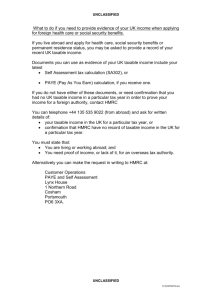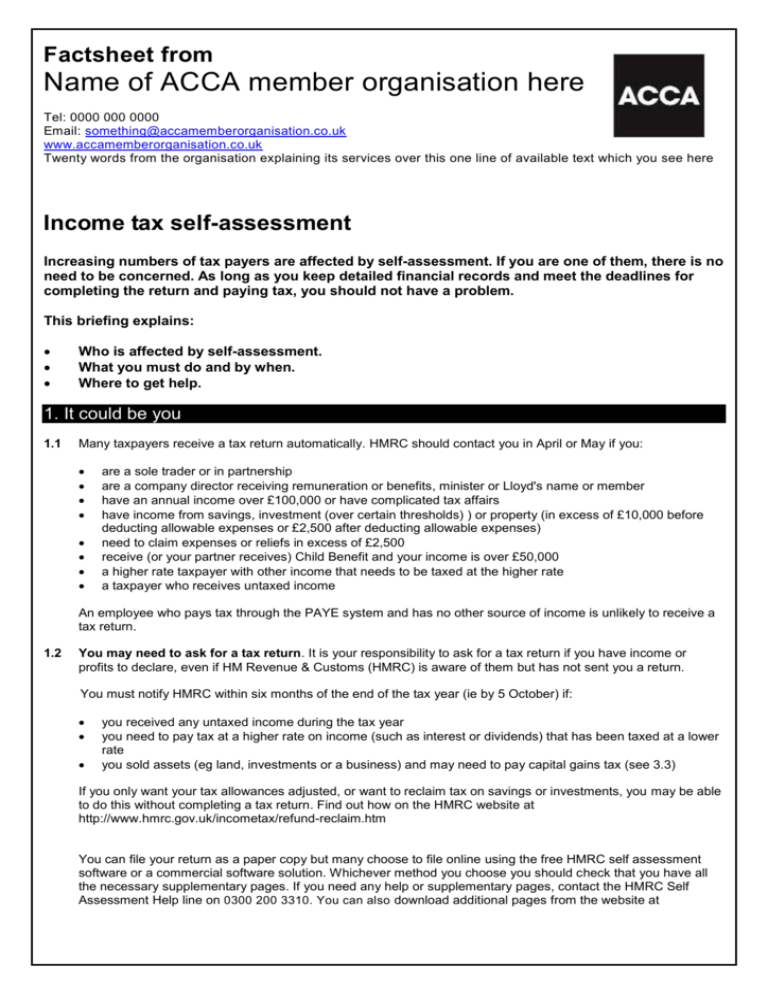
Factsheet from
Name of ACCA member organisation here
Tel: 0000 000 0000
Email: something@accamemberorganisation.co.uk
www.accamemberorganisation.co.uk
Twenty words from the organisation explaining its services over this one line of available text which you see here
Income tax self-assessment
Increasing numbers of tax payers are affected by self-assessment. If you are one of them, there is no
need to be concerned. As long as you keep detailed financial records and meet the deadlines for
completing the return and paying tax, you should not have a problem.
This briefing explains:
Who is affected by self-assessment.
What you must do and by when.
Where to get help.
1. It could be you
1.1
Many taxpayers receive a tax return automatically. HMRC should contact you in April or May if you:
are a sole trader or in partnership
are a company director receiving remuneration or benefits, minister or Lloyd's name or member
have an annual income over £100,000 or have complicated tax affairs
have income from savings, investment (over certain thresholds) ) or property (in excess of £10,000 before
deducting allowable expenses or £2,500 after deducting allowable expenses)
need to claim expenses or reliefs in excess of £2,500
receive (or your partner receives) Child Benefit and your income is over £50,000
a higher rate taxpayer with other income that needs to be taxed at the higher rate
a taxpayer who receives untaxed income
An employee who pays tax through the PAYE system and has no other source of income is unlikely to receive a
tax return.
1.2
You may need to ask for a tax return. It is your responsibility to ask for a tax return if you have income or
profits to declare, even if HM Revenue & Customs (HMRC) is aware of them but has not sent you a return.
You must notify HMRC within six months of the end of the tax year (ie by 5 October) if:
you received any untaxed income during the tax year
you need to pay tax at a higher rate on income (such as interest or dividends) that has been taxed at a lower
rate
you sold assets (eg land, investments or a business) and may need to pay capital gains tax (see 3.3)
If you only want your tax allowances adjusted, or want to reclaim tax on savings or investments, you may be able
to do this without completing a tax return. Find out how on the HMRC website at
http://www.hmrc.gov.uk/incometax/refund-reclaim.htm
You can file your return as a paper copy but many choose to file online using the free HMRC self assessment
software or a commercial software solution. Whichever method you choose you should check that you have all
the necessary supplementary pages. If you need any help or supplementary pages, contact the HMRC Self
Assessment Help line on 0300 200 3310. You can also download additional pages from the website at
www.hmrc.gov.uk/sa/forms/content.htm.
Once you have filed a self assessment tax return online HMRC will send you a notification each year rather than
the self assessment forms.
2. Your obligations
2.1
2.2
HMRC must receive your tax return by 31 October if you want to submit a paper return. You can still submit a
paper tax return after 31 October, but you will be charged a £100 late filing penalty.
If you are sending the form in the post, allow a few days for delays.
You can file your self assessment online. You must do this by the ‘fixed filing date’, which is 31 January.
The deadline for online submissions is 30 December if you owe less than £3,000 and want HMRC to collect
it by reducing your PAYE code for the next year.
If you return your completed form at any time online, HMRC will calculate any tax due automatically and
inform you of the amount immediately.
If you fail to submit your tax return by 31 January, you will incur a fine of £100.
There are additional fines for returns which are filed more than three months late and the fines increase again
after 6 and 12 months if still not submitted. See http://www.hmrc.gov.uk/sa/deadlines-penalties.htm#3 for details
2.3
You must pay your tax on time (see box).
2.4
You must keep detailed records to support the information provided in your tax return.
The self-employed, those in partnership and those who let property must keep records for five years after the
31 January filing deadline.
If you are not running a business, you are normally required to keep records for a year after the 31 January
filing deadline.
If you fail to keep adequate records, you can be fined.
3. The return
3.1
Tax returns vary in length as they are tailored to each individual’s circumstances.
HMRC will only send you the forms it thinks you need. If you use the HMRC Self Assessment Online service, it
will tailor the return to your own personal circumstances based on your answers to a few simple questions. This
means you will only have to answer the sections and questions relevant to you.
3.2
If you complete a paper return you must request any additional pages you require which are missing (see
3.3).
Everyone must fill in the main section of the tax return (paper or online).
This covers:
3.3
income from savings and investments
pensions
tax allowances and tax reliefs
state benefits
You must also complete the online or paper sections covering any other types of income and gains which apply
to you.
You will need to complete:
2
Employment section, if you were an employee for each job held during the tax year.
Self-employment, if you were a sole trader (not in partnership) or had self-employed income in addition to
your main job (eg freelance or consultancy earnings).
Partnerships, if you had partnership income. (One partner also needs to complete a partnership return.)
UK property, if you received rental income.
Foreign, if you had income from overseas investments, pensions, benefits and rents.
You do not need to complete this form for overseas employment, unless you have been taxed both overseas
and in the UK and want to reclaim tax.
Trusts, if you received income from a trust fund or have set one up.
Capital gains, if you disposed of assets and the gains were over £10,900 in 2013/14 or the total proceeds
were more than four times this amount.
You do not normally need to complete this form for private possessions, such as your main home or private
cars, unless they were used for business.
Residence, remittance basis, if you lived or worked abroad during the tax year.
4. Record-keeping
Before completing your tax return, it is essential that you gather all the information you need.
4.1
If you are an employee, you can copy most of the information required from documents given to you by your
employer.
These include:
Your P60 shows how much income tax and National Insurance you have paid during the tax year. Your
employer should give this to you by 31 May following the end of the tax year on 5 April.
Your P11D or P9D, if you receive any employee benefits or expenses.
Your employer should give you this by 6 July.
4.2
Your P45 (Part 1A), if you left employment during the tax year.
If you are self-employed or in partnership you will need:
Details of income and expenses during your last accounting year.
You will also want a copy of the previous year’s accounts for reference.
Profit and loss accounts.
Copies of your ‘statement of account’ forms, showing you how much tax you have already paid.
Your balance sheet (if you have one).
If you do not have a balance sheet, you can leave this section of your tax return blank.
4.3
If you have savings and investments, you will need:
Bank and building society passbooks and statements.
Ask for a ‘certificate of tax deducted’ for each account that pays interest net of tax.
Annual investment statements from unit trust and investment trust companies.
ISAs and PEP investments do not need to be declared on your tax return.
3
4.4
Share dividend tax vouchers.
If you contribute to a personal pension plan, you will need your annual contribution statement from your plan
provider.
5. Completing the return
Collect all your tax return forms, guidance notes and paperwork before you start to complete the return
(http://www.hmrc.gov.uk/sa/complete-tax-return.htm).
5.1
Complete the return.
5.2
Check your paper the tax return before sending it off (if you are not submitting your return online).
5.3
Write in pencil so you can make corrections. Once you are happy, complete the return in ink.
If you are unsure about an answer, give as much extra detail as possible in the ‘additional information’
boxes. This may answer any questions the tax inspector has and avoid an enquiry.
Make sure that you sign the return (this is one of the most common mistakes).
Make sure that you have included all the paperwork that you have been asked for.
Use registered post to track receipt by HMRC of your return.
If you realise you have made a mistake after sending in your tax return, you can amend it within 12 months
of the fixed filing date.
Wait for HMRC to:
5.4
The HMRC Self Assessment Online service will tailor the return to your own personal circumstances so you
only have to answer questions relevant to you.
Software will allows you to enter, change, delete and save any entries; so you can review the data before
you finalise the return for submission. You can also print or keep a copy for your records.
Only include income and gains during the tax year — from 6 April to 5 April — unless asked to do otherwise.
Once you are happy with your return, submit it online. You will be sent a receipt for your records.
The software will produce a tax calculation giving details of the amounts due and the dates for the payments.
check for mistakes and then send you a new tax calculation if necessary
calculate your tax bill (if you have not done this already)
notify you if it plans to enquire into your return
You must pay any tax owing by 31 January even if you do not receive a demand.
6. Getting help
6.1
Half of all taxpayers complete their returns without professional help.
If you are an employee, filling in your tax return is usually straightforward.
6.2
Provided you have the correct information, it may take no longer than a weekend.
Make the most of HMRC advice and online services.
Consider using the HMRC Self Assessment Online service to file your return (www.hmrc.gov.uk/sa/fileonline.htm). It is secure and will calculate your tax automatically.
You can see a demonstration of the Self Assessment Online service at www.hmrc.gov.uk/demo.
4
6.3
Use the guidance notes sent with your tax return.
Ring the Self Assessment helpline (0300 200 3310) and ask for free HMRC helpsheets which explain
different aspects of tax and give further information on how to complete your tax return.
If you are self-employed or have complicated financial arrangements, consider employing a qualified accountant
or tax adviser.
A good accountant or tax adviser will:
help you ensure you pay the right amount of tax
be able to calculate your tax bill.
Your adviser’s fees may be a tax-deductible expense.
6.4
Choose your adviser carefully.
6.5
Qualified accountants should be members of the Institute of Chartered Accountants in England and Wales
(ACA or FCA), Association of Chartered Certified Accountants (ACCA or FCCA), Chartered Institute of
Management Accountants (ACMA or FCMA) or Chartered Institute of Public Finance and Accountancy
(CPFA). Accounting staff may be members of the Association of Accounting Technicians (MAAT).
Tax advisers are members of the Chartered Institute of Taxation (CTA, ATII or FTII) or the Association of
Taxation Technicians (ATT).
Remember your responsibilities.
Even if you employ an adviser you may have to do the day-to-day paperwork yourself unless they provide you
with bookkeeping services.
You will have to supply details of income, invoices, receipts and expenses.
It is still your responsibility to ensure that your tax return is correct, is filed by the deadline and any tax owing
is paid on time.
When is the tax due?
There are two tax payment dates in the year — 31 January and 31 July.
A.
If you are an employee, you may only need to make one payment, by 31 January (ten months after the end of
the tax year).
This will be any tax you owe after taking into account the tax already deducted from your salary under PAYE.
B.
If you owe less than £2,000 and submit your return by 30 December online, the tax can be collected from
your salary under PAYE.
If you are self-employed or owe additional tax, you are usually required to make two payments ‘on account’,
based on your profits for the previous year.
The first has to be paid by 31 January, before the end of the current tax year. The second, by 31 July, is after the
end of the tax year. Any outstanding tax must then be paid by the following 31 January.
Interest is charged on late payments.
A 5% surcharge will be charged on any outstanding tax remaining unpaid after 30 days.
A further 5% surcharge will be charged on any outstanding tax remaining unpaid after six months.
An additional 5% if the tax is unpaid 12 months later.
5
Experts’ quotes
”The most important thing is to ensure that your records (of income and expenditure) are well organised and that you
retain invoices and receipts to support all amounts claimed on your tax return. That way if HMRC ever enquires into
your figures you will save a lot of stress and fees.”
Martin Dunne,
Sayers Butterworth LLP
Expert contributors
Thanks to Martin Dunne (Sayers Butterworth LLP, 0207 935 8504, www.sayersb.co.uk), Glenn Collins (Association of
Chartered Certified Accountants, 0207 059 5956), Elaine Clark (www.cheaperaccounting.co.uk, 0844 884 2399).
Last updated 01.04.14
© Atom Content Marketing 2014. ISSN 1369-1996. All rights reserved. No part of this publication may be reproduced or transmitted without the
written permission of the publisher. This publication is for general guidance only. The publisher, expert contributors and distributor disclaim all liability
for any errors or omissions. Consult your local business support organisation or your professional adviser for help and advice.
6

